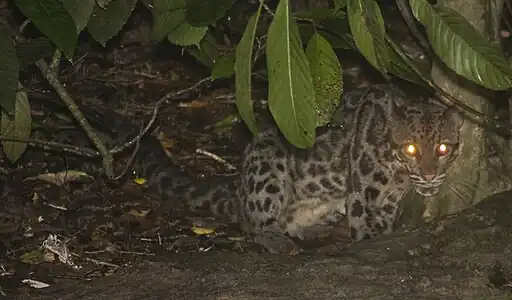| Bornean clouded leopard | |
|---|---|
 | |
| A Bornean clouded leopard along the lower Kinabatangan, eastern Sabah, Malaysia | |
| Scientific classification | |
| Domain: | Eukaryota |
| Kingdom: | Animalia |
| Phylum: | Chordata |
| Class: | Mammalia |
| Order: | Carnivora |
| Suborder: | Feliformia |
| Family: | Felidae |
| Subfamily: | Pantherinae |
| Genus: | Neofelis |
| Species: | |
| Subspecies: | N. d. borneensis |
| Trinomial name | |
| Neofelis diardi borneensis Wilting, Christiansen, Kitchener, Kemp, Ambu and Fickel, 2007 | |
The Bornean clouded leopard (Neofelis diardi borneensis) is a subspecies of the Sunda clouded leopard. It is native to the island of Borneo, and differs from the Batu-Sumatran clouded leopard in the shape and frequency of spots, as well as in cranio-mandibular and dental characters.[1] In 2017, the Cat Classification Taskforce of the Cat Specialist Group recognized the validity of this subspecies.[2]
Habitat and distribution
In Kalimantan, it was recorded in Sabangau National Park.[3]
In northern Sarawak, it was recorded in mixed dipterocarp forest outside a protected area at elevations of 1,000 to 1,215 m (3,281 to 3,986 ft).[4]
In Sabah, it was recorded in Danum Valley Conservation Area, Ulu Segama, Malua and Kabili-Sepilok Forest Reserves, Tabin Wildlife Reserve and the Lower Kinabatangan Wildlife Sanctuary.[5]
Ecology
Results of a camera-trapping survey revealed that it is largely nocturnal. A radio-collared female had a home range of around 23 km2 (8.9 sq mi) in 109 days.[6]
Evolution
The Bornean clouded leopard is estimated to have diverged from the Sumatran clouded leopard in the Late Pleistocene, between 400 and 120 thousand years ago. Land bridges that were created due to low sea levels in the Late Pleistocene were submerged by rising sea levels, resulting in the Bornean clouded leopard becoming separated from the mainland population at this time.[7] It was recognized as its own subspecies in 2007 following an analysis of the genetic substructure of the Bornean and Sumatran clouded leopards, which concluded that there was enough genetic variation to recognize the Sumatran Neofelis diardi diardi and the Bornean Neofelis diardi borneensis as two different subspecies.[8]
Threats
The Bornean clouded leopard is considered vulnerable, similar to other Neofelis species, due to anthropogenic disturbances such as deforestation, illegal poaching, and hunting pressure.[9] In Sabah, habitat loss is primarily driven by the development of oil palm plantations, which inhibits connectivity of the Bornean clouded leopard population.[10]
See also
References
- ↑ Wilting A.; Christiansen P.; Kitchener A. C.; Kemp Y. J. M.; Ambu L. & Fickel, J. (2010). "Geographical variation in and evolutionary history of the Sunda clouded leopard (Neofelis diardi) (Mammalia: Carnivora: Felidae) with the description of a new subspecies from Borneo". Molecular Phylogenetics and Evolution. 58 (2): 317–328. doi:10.1016/j.ympev.2010.11.007. PMID 21074625.
- ↑ Kitchener, A. C.; Breitenmoser-Würsten, C.; Eizirik, E.; Gentry, A.; Werdelin, L.; Wilting, A.; Yamaguchi, N.; Abramov, A. V.; Christiansen, P.; Driscoll, C.; Duckworth, J. W.; Johnson, W.; Luo, S.-J.; Meijaard, E.; O'Donoghue, P.; Sanderson, J.; Seymour, K.; Bruford, M.; Groves, C.; Hoffmann, M.; Nowell, K.; Timmons, Z. & Tobe, S. (2017). "A revised taxonomy of the Felidae: The final report of the Cat Classification Task Force of the IUCN Cat Specialist Group" (PDF). Cat News (Special Issue 11).
- ↑ Cheyne, S.M. & Macdonald, D.W. (2011). "Wild felid diversity and activity patterns in Sabangau peat-swamp forest, Indonesian Borneo". Oryx. 45 (1): 119–124. doi:10.1017/S003060531000133X.
- ↑ Mathai, J.; Buckingham L.; Ong N. (2014). "Borneo bay cat and other felids in a logging concession in Sarawak, Malaysian Borneo". Cat News. 60: 34–35.
- ↑ Ross, J.; Hearn, A.J.; Johnson, P.J. & Macdonald, D.W. (2013). "Activity patterns and temporal avoidance by prey in response to Sunda clouded leopard predation risk". Journal of Zoology. 290 (2): 96–106. doi:10.1111/jzo.12018.
- ↑ Hearn, A.J.; Ross, J.; Pamin, D.; Bernard, H.; Hunter, L. & Macdonald, D.W. (2013). "Insights into the spatial and temporal ecology of the Sunda clouded leopard Neofelis diardi". Raffles Bulletin of Zoology. 61 (2): 871–875.
- ↑ Buckley-Beason, V. A.; Johnson, W. E.; Nash, W. G.; Stanyon, R.; Menninger, J. C.; Driscoll, C. A.; Howard, J. G.; Bush, M.; Page, J. E.; Roelke, M. E. & Stone, G. (2006). "Molecular Evidence for Species-Level Distinctions in Clouded Leopards". Current Biology. 16 (23): 2371–2376. doi:10.1016/j.cub.2006.08.066. PMC 5618441. PMID 17141620.
- ↑ Wilting, Andreas; Buckley-Beason, Valerie A.; Feldhaar, Heike; Gadau, Jürgen; O'Brien, Stephen J. & Linsenmair, K Eduard (2007). "Clouded leopard phylogeny revisited: support for species recognition and population division between Borneo and Sumatra". Frontiers in Zoology. 4 (15): 15. doi:10.1186/1742-9994-4-15. PMC 1904214.
- ↑ Hearn, A. J.; Ross, J.; Bernard, H.; Bakar, S. A.; Gossens, B.; Hunter, L. T. B. & Macdonald, D. W. (2019). "Responses of Sunda clouded leopard Neofelis diardi population density to anthropogenic disturbance: refining estimates of its conservation status in Sabah". Oryx. 53 (4): 643–653. doi:10.1017/S0030605317001065.
- ↑ Hearn, A. J.; Cushman, S. A.; Goossens, B.; Ross, J.; Macdonald, E. A.; Hunter, L. T. B.; Macdonald, D. W. (2019). "Predicting connectivity, population size and genetic diversity of Sunda clouded leopards across Sabah, Borneo". Landscape Ecology. 34 (2): 275–290. doi:10.1007/s10980-018-0758-1.
External links
- "Borneo Clouded Leopard". YouTube (Video). Archived from the original on 2021-12-15.
